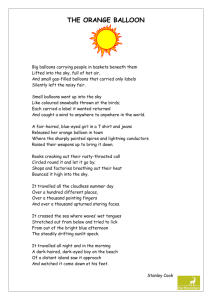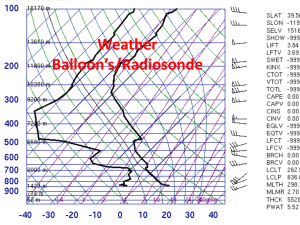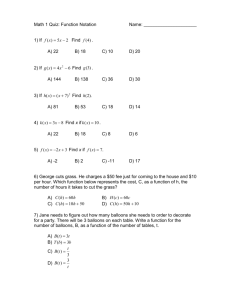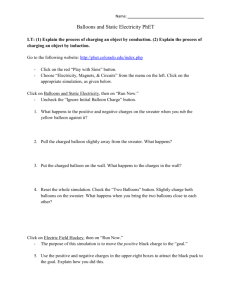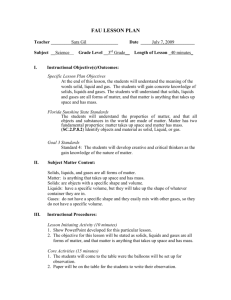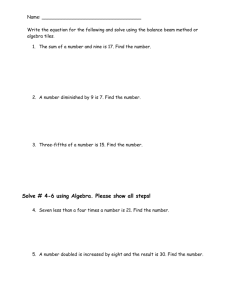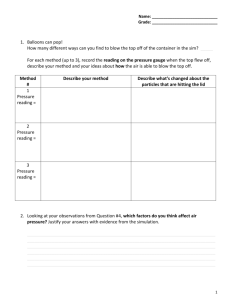density_unit_plan
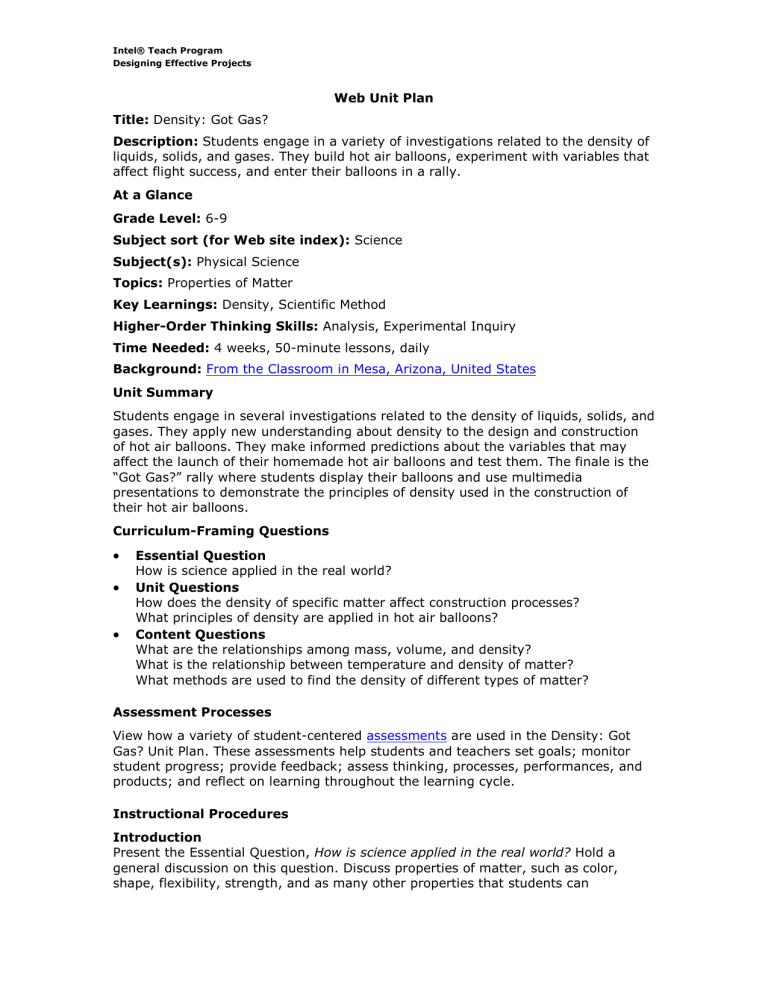
Intel® Teach Program
Designing Effective Projects
Web Unit Plan
Title: Density: Got Gas?
Description: Students engage in a variety of investigations related to the density of liquids, solids, and gases. They build hot air balloons, experiment with variables that affect flight success, and enter their balloons in a rally.
At a Glance
Grade Level: 6-9
Subject sort (for Web site index): Science
Subject(s): Physical Science
Topics: Properties of Matter
Key Learnings: Density, Scientific Method
Higher-Order Thinking Skills: Analysis, Experimental Inquiry
Time Needed: 4 weeks, 50-minute lessons, daily
Background: From the Classroom in Mesa, Arizona, United States
Unit Summary
Students engage in several investigations related to the density of liquids, solids, and gases. They apply new understanding about density to the design and construction of hot air balloons. They make informed predictions about the variables that may affect the launch of their homemade hot air balloons and test them. The finale is the
“Got Gas?” rally where students display their balloons and use multimedia presentations to demonstrate the principles of density used in the construction of their hot air balloons.
Curriculum-Framing Questions
Essential Question
How is science applied in the real world?
Unit Questions
How does the density of specific matter affect construction processes?
What principles of density are applied in hot air balloons?
Content Questions
What are the relationships among mass, volume, and density?
What is the relationship between temperature and density of matter?
What methods are used to find the density of different types of matter?
Assessment Processes
View how a variety of student-centered assessments are used in the Density: Got
Gas? Unit Plan. These assessments help students and teachers set goals; monitor student progress; provide feedback; assess thinking, processes, performances, and products; and reflect on learning throughout the learning cycle.
Instructional Procedures
Introduction
Present the Essential Question, How is science applied in the real world? Hold a general discussion on this question. Discuss properties of matter, such as color, shape, flexibility, strength, and as many other properties that students can
Intel® Teach Program
Designing Effective Projects brainstorm and why the properties might be important. Tell students that for the next few weeks, they will be investigating the property of density. Have them write everything they know about density and why density might be important.
Density Investigations
Have students investigate specific properties of matter with the Layered Liquids Lab .
In this lab, students layer mystery liquids and compare their relative densities. Give each team one set of equipment (see materials on the lab worksheet). The liquids are as follows:
A=Water (dyed red with food coloring)
B=Corn oil
C=Lite corn syrup
D=Rubbing alcohol
E=Lite pancake syrup
Each group should have 5 ml of each unknown liquid. Directions for the students are given in the "Procedure" section on the lab sheet. (Note that this procedure can also be done as a teacher-only demonstration.)
Explain that students will move from comparing density to measuring the density of liquids. Have students complete the Density Lab * on the Internet (requires
Macromedia Shockwave*) in groups or as a class. Be sure to make copies of handout
2 found on the Web site. Through this Internet exercise, students should make a connection between the Layered Liquids Lab and the Internet Density Lab. After the lab, discuss the Content Question, What are the relationships among mass, volume,
and density?
Expand on the experiments from the Internet Density Lab by discussing operational definitions and how to calculate density using the How Dense?
Lab. Explain to students that they will measure the absolute densities of liquids from the Layered
Liquids Lab. Note that the liquids are the same as those compared in the Layering
Liquids Lab. Each group's lab setup requires 25 ml of each sample liquid. Discuss procedures and data collection in advance of the activity. Explain to student’s that a bar graph would be more appropriate for this type of data. Also, this would be a good opportunity to use a spreadsheet program to input the data and make various types of graphs. Students would quickly see what types of graphs are more revealing and useful.
Teach about the density of solids and have students complete a solids lab. Before beginning, ask students what they learned about comparing the density of fluids that might help them think about measuring the density of a solid. (Mass is determined by comparing an object of unknown mass to an object of known mass, using a balance scale.) Have students engage in a lab investigating the density of solids. The solids lab document details procedures for this activity. Students should be able to find the density of a variety of objects using the appropriate method by the end of this session. Note that students will need two cubes made from different materials
(for example, steel and aluminum) and an irregular sample of either steel or aluminum to complete this lab.
Ask students, If you put hot and cold water together, what will happen? Discuss predictions and then do the following hot/cold density demonstration:
1.
Fill one jar with hot water, colored red.
2.
Fill another jar with cold water, colored blue.
Intel® Teach Program
Designing Effective Projects
3.
Invert hot over cold, using a plastic separator card placed between the two jars.
Once inverted, remove the card quickly.
4.
Observe what happens and discuss how students’ predictions turned out.
5.
Repeat, but this time invert the cold jar over the hot jar.
6.
Observe and discuss how students’ predictions turned out. Ask students, what the explanation might be for what was observed. Have students write or discuss what ways temperature affects density.
Ask students, what the explanation might be for what was observed. Have students write or discuss what ways temperature affects density. Show the class the Internet simulation Molecules in Motion * to demonstrate what happens to gas molecules under different temperatures. Discuss scientific modeling and explain how molecules have been modeled in different ways over time. Discuss density of gases as compared to solids and liquids.
Applying Density Concepts to Hot Air Balloons
Students are now ready to apply their knowledge about density in the construction of a hot air balloon. Present the Unit Questions: How does the density of specific matter
affect the construction process? and What principles of density are applied in hot air balloons?
Divide students into small groups. Announce that the class will be hosting the “Got
Gas”? Hot Air Balloon Rally. The students’ task is to construct hot air balloons that will give riders the smoothest and longest flight. The students will work in groups and research how hot air balloons work and which variables to consider when constructing balloons. Guide this activity with the balloon research worksheet.
Have groups create a balloon name and list as many variables that affect flight time as they can. Discuss these variables as a class, and have students expand and modify notes accordingly.
Give each student an experiment data sheet , and present the problem, What causes
some hot air balloons to have longer flight times than others? Instruct students to discuss this within their groups, and write hypothesis and prediction statements.
(Help narrow the choices of independent variables to those relating to balloon weight, temperature difference inside and outside the balloon, wind speed, and direction.) Have each group make a chart showing independent, dependent, and constant variables.
Instruct students to research the materials needed to build their balloons using the
Internet sources listed. Students should consider the density of each of their chosen materials (such as straws, plastic sheeting, string, paper cups, and so forth) and provide a rationale for their choices. Have groups turn in a list of supplies needed to build their balloon and have those supplies ready by the next class or have students bring in their own supplies. A pattern of a hot air balloon is included as an example, or each group can find or make their own pattern.
Students are now ready for construction day. Explain that groups should document the density of each type of material used in their hot air balloon and the rationale for choosing the material. They should also describe how they used principles of density to ensure a long flight time and smooth ride.
Hold the “Got Gas?” Hot Air Balloon Rally! Assign each group a designated flight time. Flight is judged by time, integrity of materials, and smoothness of ride. Tell students to set up a data table and graph while waiting for flight times, and work on
Intel® Teach Program
Designing Effective Projects their presentations by drawing illustrations of their project to scan into later publications and/or taking pictures.
Share the student example slideshow and discuss the criteria for the presentations.
Introduce the presentation rubric and keeping track brochure checklist . Explain that students are to complete two presentation projects:
A technical brochure explaining the group’s newly acquired knowledge of density. Show demonstrating learning as an example. Discuss features of the brochure using plan the brochure . These criteria are also listed in the keeping track brochure checklist .
A slideshow presentation about the design and construction of the group’s hot air balloon and how they used principles of density to enhance the design.
See the presentation rubric for criteria. Provide students a workday for their multimedia presentations and brochures. Be sure that students work in teams and divide the workload. Distribute and discuss the peer rubric and ask students to refer to it while they work in their groups. Students may need a couple days to complete this step.
Have groups present their multimedia presentations and display their brochures.
Have students self- and peer-assess their collaboration skills using the peer rubric and their presentations using the presentation rubric .
Note: In addition to the student brochure and slideshow presentations, students may
develop a class wiki * on the topic of density.
Conclusion
Students use the density test practice to review the concepts of the density lessons and prepare for the short-answer and practical exam .
Present the Essential Question again, How is science applied in the real world? Use density as the focus this time. Encourage students to further investigate this question by researching other examples when knowing the density of matter is applied to other situations (such as density of gold to identify fool’s gold, packaging material, body density, all construction projects, and so forth).
Prerequisite Skills
Basic computer skills, such as keyboarding and word processing
Experience with word processing, spreadsheet, and multimedia programs
Understanding of the scientific method, experimental designs, and operational definitions
Differentiated Instruction
Resource Student
Give the student extra time and individual instruction
Have support personnel or volunteers help with lab assignments
Reduce the number of concepts needed to master
Pair the student with a buddy
Intel® Teach Program
Designing Effective Projects
Gifted Student
Instruct an advanced student to complete an independent research topic, such as finding how important density of material is to objects like space shuttles and ocean liners, or investigating buoyant force, air pressure, and Boyle’s and
Charles’s Gas Laws
Have the student compile all students’ work on a class wiki or help others with labs and computer work
English Language Learner
Allow the student to study science concepts with an ELL assistant during supplemental instruction outside of class
Pair the student with others during project work when the language load indicates a necessity
Have the student prepare materials in the student’s first language.
Credits
Gina Aldridge participated in the Intel® Teach Program, which resulted in this idea for a classroom project. A team of teachers expanded the plan into the example you see here.
THINGS YOU NEED (highlight box)
Assessment Plan
Assessment Timeline
Before project work
begins
Students work on project and complete tasks
After project work is completed
Questioning Observations of Lab
Participation
Observations of Lab
Participation
Questioning
Peer Rubric
Presentation
Rubric
Brochure
Checklist
Presentation
Rubric
Peer Rubric
Questioning
Density Test
Practice
Exam
Questioning is used throughout the unit to help students develop their higher-order thinking skills and process content. Students use the brochure checklist to help guide their learning, stay on track, and self-assess their progress. Observe lab participation throughout to monitor learning and adjust and redirect teaching. Ask students to use the presentation rubric and peer rubric to help them self- and peer-assess their work. Use this same presentation rubric to assess and grade the final project. Review the concepts of the density lessons using the Density Test Practice before administering the short answer and practical exam .
Targeted Content Standards and Benchmarks
Arizona Content Standards and Benchmarks
Science
Intel® Teach Program
Designing Effective Projects
Employ a research design that incorporates a scientific method
Predict the outcome when matter experiences an external force or energy change
Analyze physical properties of a substance through observation, measurement, and experimentation
Identify qualitative and quantitative relationships associated with energy (such as heat, mechanical)
Technology
Plan, produce, and present an effective multimedia presentation using visual media, including cartoons, computer images, charts, photographs, maps, and tables, to communicate the intended purpose to the audience
Select and use appropriate technologies to gather, process, and analyze data and to report information related to an investigation
Student Objectives
Students will be able to:
Determine densities of regular solids, irregular solids, and liquids
Interpret density information to gain understanding about an object’s physical
properties
Apply understanding of differences in density of gases due to temperature to make a working hot air balloon
Use the scientific method to develop and test hypotheses about variables that
affect the flight time of balloons
Use various written and visual presentation tools to effectively communicate learning
Technology and Resources:
Supplies
Red dyed water
Blue dyed water
Corn oil
Lite corn syrup
Rubbing alcohol
Lite pancake syrup
Test tubes
Graduated cylinders
Triple beam balances
Two cubes of different material that are similar in looks (such as steel and aluminum) and an odd shaped slab of one of the cube’s material
Rulers
Hot air guns
Glue
Scissors
Tissue paper for hot air balloons
Blow dryer or other sources of heat (for example, hot air popcorn poppers)
Other supplies that might show up on student’s list, such as straws, strings, paper cups, plastic, balsa wood, cellophane, 22-gauge electrical wires, and so forth
Internet Resources
Intel® Teach Program
Designing Effective Projects
Explore Learning www.explorelearning.com/index.cfm?method=cResource.dspView&ResourceID=3
62 *
An interactive simulation about density in which students calculate the density of unknown objects by finding the mass and volume; students are also asked to create charts and answer questions based on the data
Explore Learning www.explorelearning.com/index.cfm?method=cResource.dspView&ResourceID=2
3 *
An interactive simulation showing the effects of weight on a floating log; students calculate how much weight can be added to a floating log before it sinks
ChemConnections http://mc2.cchem.berkeley.edu/Java/molecules/index.html
*
An interactive simulation about the effects of mass, number of objects, and temperature on internal pressure
Air Travelers www.omsi.edu/explore/physics/air *
An introduction to the basic principles of buoyancy, properties of gases, temperature, and the technology involved in hot air ballooning
It’s a Matter of Density http://teachertech.rice.edu/Participants/louviere/Lessons/les6.html
*
A lab activity about measuring density of liquids and regular and irregular solids
Virtual Chembook www.elmhurst.edu/~chm/vchembook/123Adensitygas.html
*
Information on the density of gases and how temperature affects the density, including a link to a hot air balloon site that demonstrates this principle in action as well as other density demonstrations
How Stuff Works http://travel.howstuffworks.com/hot-air-balloon.htm
*
Information on how hot air balloons work and the scientific principles involved
Gander Academy www.cdli.ca/CITE/balloon.htm
*
A description of Web sites that explain the science and history that pertains to hot air balloons
NASA http://imagine.gsfc.nasa.gov/docs/ask_astro/answers/970106a.html
*
An explanation of how buoyant force and the ideal gas laws apply to hot air balloons
Nova: Floating and Sinking www.pbs.org/wgbh/nova/balloon/science/density *
Explains in concise language why hot air balloons float and sink
Nova: The Science of Ballooning www.pbs.org/wgbh/nova/balloon/science *
A more involved explanation of the science of hot air balloons
Community Learning Network
www.cln.org/themes/hot_balloons.html
*
Resources for hot air balloon site, including one resource that shows different models of hot air balloons that you can make
Overflite www.overflite.com/science.html
*
An example of how to build a hot air balloon, including mathematical information that pertains to hot air balloons
Intel® Teach Program
Designing Effective Projects
Balloon Zone www.balloonzone.com/balloonparts.html
*
Describes parts of a hot air balloon
Technology—Hardware
Digital camera for taking pictures throughout the design stages so students can use the images in their presentations
Computer(s) for conducting research for hot air balloons, density activities, brochures, and multimedia presentations
Internet connection for research and wiki creation
Projection system to present density Web sites and project instructions
Scanner to scan charts, graphs, diagrams, and hand-drawn pictures that can be used in the brochure and multimedia presentations
Video camera to film the “Got Gas?” Hot Air Balloon Rally
Technology—Software
Database or spreadsheet so students can input data from the balloon rally into their presentations
Desktop publishing so some students may use this for brochure documents
Image processing to edit pictures from cameras, the Internet, or scanners to put into presentations
Internet web browser to access the Internet for research about density and hot air balloons
Multimedia to create brochures and slideshow presentations about the hot air balloons
Word processing to create documents for project presentations
